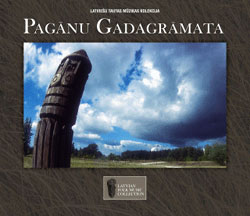
UPE Recording, the Rīga-based music production company run by singer and disc jockey Ainars Mielavs, in February released the first of what it promises will be a series of recordings chronicling the vast catalog of Latvian folk songs. Pagānu gadagrāmata (Pagan Yearbook), the brainchild of Uģis Prauliņš, is not, however, the typical collection of folk songs.
In fact, Latvian audiences unaccustomed to what’s been happening in the field of "world music" might be taken aback by the cycle of songs on this album. Pagānu gadagrāmata is not an introductory library of folk tunes. Rather, it is a concept album tied to the theme of the passing of the seasons. During the course of 15 tracks, the listener is carried from the atkūsnis (thaw) that occurs around Easter time, forward through spring, summer, autumn and winter.
This also is an album about the Latvian countryside, home of the Latvian soul. That helps explain the various "nature" sound effects scattered through the album, a somewhat trite addition to an otherwise fine recording.
Pagānu gadagrāmata is not a singalong album that lends itself well to air play, even though tracks have been featured on Radio Latvia and some commercial stations. Instead, the album is better listened to in a single sitting, maybe even with the "repeat" function of your CD player activated, so you can experience several "years" in row.
"I wouldn’t like these songs to climb the Latvian pop charts and go down as swiftly afterwards," Prauliņš writes in the liner notes. "These songs are meant to be a retrospection of a whole year for the inner self of an urban man—at places we hardly ever visit these days."
Familiar voices, such as that of Latvian folk diva Ilga Reizniece, sing traditional lyrics (dainas) but often to the accompaniment of nontraditional instruments, such as the West African xylophone, the balafon, and the hand drum, the djembe. Thus, we find Prauliņš singing "Meitas gula ābolajē"—with Prauliņš himself handling voice, keyboards, and recorder—ending with bongos that segue into Reizniece and Māris Muktupāvels singing a percussive "Ganiņš biju" on a track punctuated by the djembe and the balafon.
The arrangements are a sign that "folk" culture does not have to be restricted to a specific time in the past to be considered genuine. Consider as an example "Baladīte," a tragic ballad composed by Prauliņš with lyrics drawn from the work of poet Ojārs Vācietis (1933-1983).
Featured performers on the album are Reizniece and Muktupāvels, both of the post-folk group Ilgi; guitarist Gints Sola of Jauns Mēness; and bassist Andris Alviķis, percussionist Nils Īle, and Prauliņš. In a recent interview in the Rīga daily newspaper Diena, Prauliņš told journalist Uldis Rudaks that the idea for Pagānu gadagrāmata came to him in 1995. For some tracks on the album, Prauliņš arranged the music around the traditional songs transcribed by the Latvian folklorist, composer, and critic Emilis Melngailis (1874-1954). Other tracks, such as the instrumental “Pirmais pērkons,” are new compositions.
We hope UPE does well with this series. Latvian folk music, important though it is to Latvian ethnic identity, has received scant recent attention from recording companies in Latvia. Mielavs tells SVEIKS.com that the second album in the series, Latviešu danči (Latvian Dances), is nearing completion, and that at least one additional album is expected this year.
(Editor’s note: This review originally appeared on SVEIKS.com.)
Details
Pagānu gadagrāmata
Latviešu tautas mūzikas kolekcija
UPE Recording Co., 1999
UPE CD 009
© 1995-2024 Latvians Online
Please contact us for editorial queries, or for permission to republish material. Disclaimer: The content of Web sites to which Latvians Online provides links does not necessarily reflect the opinion of Latvians Online, its staff or its sponsors.




